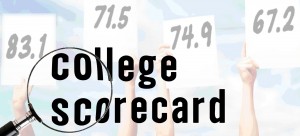
So you or your child wants to go to college? Terrific. Investing in education is a wise use of time, helping to ensure that communities are full of well-rounded, engaged people who actively participate in the world.
But the challenge remains: which college to choose?
It’s never been so hard to answer that question. There are thousands of colleges and universities all over the country, and college can cost a lot of money. Everyone wants to find the “right” college, but what that means varies from person to person.
There are college counselors and magazines, websites, and friends who offer information; the government wants to help too.
A few weeks ago U.S. Department of Education released a mountain of data about colleges and universities as part of a revamped “College Scorecard.” This tool, partly of ED’s College Affordability and Transparency Center, aims to help people assess a school’s affordability and value so that they can pick an appropriate institution. Some even claim that the Scorecard will change how students choose colleges.
But it shouldn’t.
Yes, it’s possible to use the new tool to look up a college you think you want to attend and find out that it’s too expensive, or that most students who go there end up in debt they have trouble paying off. You might even be surprised to learn that while the college charges a lot of money, most of the students don’t earn a lot of money after college. That’s good to know, but you can be easily misled.
Consider that the school that seems most affordable and open to students who have little money or are the first in their family to attend college is…Harvard. That’s because the Scorecard focuses on price and graduation rates and earnings after college, and neglects to mention a really important factor: admissions. For that information, you have to cruise over to College Navigator, where you’ll learn that Harvard receives more than 34,000 applications a year and admits just 6% of those people. It doesn’t help much if the most affordable college with the highest graduation rate is impossible to get into, yet according to the Scorecard Harvard is tops, along with MIT and Stanford.
It’s also a problem that the Scorecard implies that what a given college’s students earn, or how they do at paying off their debt, has nothing to do with who attends that college or what they did in college. We should expect colleges that mainly enroll wealthy students to have high graduation rates, low debt, and high post-college earnings. These students would have these advantages almost no matter where they went to college. But the wealth of a college’s students cannot be observed using the Scorecard.
Even so, you’ll be tempted to ask—why does College A look like this and College B look like that? And that precisely what the Scorecard really isn’t good for answering. Comparing colleges requires a lot more work and information than the Scorecard or any comparable simple tool provides. Taking the graduation rate or the earnings of a college that admits 80% of applicants and enrolls loads of students from low-income families and comparing those outcomes to those of a college that cherry-picks the wealthy students it admits is irresponsible. You shouldn’t conclude that New York University is “better” because its graduates earn more than the City University of New York’s graduates. They serve very different students.
So here’s what the Scorecard is good for:
- Looking up information to get to know a college better. Test your assumptions. Did you think College X admitted a lot of low-income students or had a high overall graduation rate? Maybe you’re wrong. Good to know. You can see who pays what and where. That’s helpful.
- Using the information when discussing college with people advising on the decision. The Scorecard can help identify topics to discuss and guide the conversation. The person you work with should be able to tackle questions you have about the Scorecard, and if they don’t, you need to keep asking until you get answers.
But please, don’t act as if the Scorecard actually gives a college a score. It doesn’t.
Families shouldn’t rule out a college or decide on one using this information. If students want to reach for college, they need to talk to knowledgeable people who can help.
Start there.
Sara Goldrick-Rab is Professor of Educational Policy Studies and Sociology at the University of Wisconsin-Madison. She is also Senior Scholar at the Wisconsin Center for the Advancement of Postsecondary Education and an affiliate of the Center for Financial Security, Institute for Research on Poverty, and the Consortium for Chicago School Research. In 2014, she founded the Wisconsin Harvesting Opportunities for Postsecondary Education (HOPE) Lab.

Comments